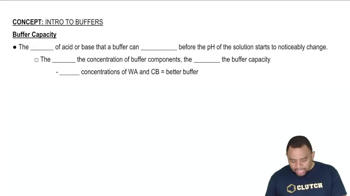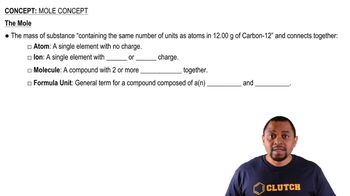The fluids within cells are buffered by H2PO4- and HPO42- . b. Could a buffer system employing H3PO4 as the weak acid and H2PO4- as the weak base be used as a buffer system within cells? Explain.
Ch.18 - Aqueous Ionic Equilibrium
Chapter 18, Problem 63a
A 500.0-mL buffer solution is 0.100 M in HNO2 and 0.150 M in KNO2. Determine if each addition would exceed the capacity of the buffer to neutralize it. a. 250 mg NaOH
 Verified step by step guidance
Verified step by step guidance1
1. First, we need to understand what a buffer is. A buffer is a solution that can resist pH change upon the addition of an acidic or basic components. It is able to neutralize small amounts of added acid or base, thus maintaining the pH of the solution relatively stable. This is achieved by including a weak acid and its conjugate base in the solution. In this case, HNO2 is the weak acid and KNO2 is the salt of its conjugate base NO2-.
2. The capacity of a buffer is the amount of acid or base that can be added to it without causing a significant change in pH. It is directly proportional to the concentrations of the weak acid and its conjugate base in the buffer. In this case, the buffer is 0.100 M in HNO2 and 0.150 M in KNO2.
3. To determine if the addition of NaOH would exceed the buffer's capacity, we need to calculate the moles of NaOH added. NaOH is a strong base and will react with the weak acid HNO2 in the buffer. The molar mass of NaOH is approximately 40 g/mol. So, 250 mg (or 0.250 g) of NaOH is 0.250 g / 40 g/mol = 0.00625 mol.
4. The buffer can neutralize 0.100 mol/L * 0.500 L = 0.050 mol of NaOH. This is because the HNO2 can react with the OH- ions from the NaOH to form water and NO2- ions.
5. Compare the moles of NaOH added to the buffer's capacity. If the moles of NaOH added is less than or equal to the buffer's capacity, then the buffer can neutralize the added NaOH. If the moles of NaOH added is greater than the buffer's capacity, then the buffer cannot neutralize all of the added NaOH, and the pH of the solution will change significantly.

Verified video answer for a similar problem:
This video solution was recommended by our tutors as helpful for the problem above.
Video duration:
3mWas this helpful?
Key Concepts
Here are the essential concepts you must grasp in order to answer the question correctly.
Buffer Solutions
Buffer solutions are mixtures that resist changes in pH when small amounts of acid or base are added. They typically consist of a weak acid and its conjugate base, or a weak base and its conjugate acid. In this case, HNO2 (a weak acid) and KNO2 (the salt of its conjugate base) form a buffer that can neutralize added acids or bases.
Recommended video:
Guided course

Buffer Solutions
Buffer Capacity
Buffer capacity refers to the amount of acid or base that a buffer solution can neutralize before a significant change in pH occurs. It depends on the concentrations of the buffer components; higher concentrations lead to greater capacity. In this scenario, the buffer's capacity will determine if the addition of NaOH exceeds its ability to maintain pH.
Recommended video:
Guided course

Buffer Capacity
Calculating Moles of Added Substance
To assess the impact of adding a substance like NaOH to a buffer, it's essential to calculate the number of moles being added. This is done using the formula: moles = mass (g) / molar mass (g/mol). For 250 mg of NaOH, converting to grams and then using its molar mass allows for determining how many moles are introduced to the buffer system.
Recommended video:
Guided course

Mole Concept
Related Practice
Textbook Question
Textbook Question
Which buffer system is the best choice to create a buffer with pH = 9.00? For the best system, calculate the ratio of the masses of the buffer components required to make the buffer. HF/KF HNO2/KNO2 NH3/NH4Cl HClO/KClO
Textbook Question
A 500.0-mL buffer solution is 0.100 M in HNO2 and 0.150 M in KNO2. Determine if each addition would exceed the capacity of the buffer to neutralize it. b. 350 mg KOH
Textbook Question
A 500.0-mL buffer solution is 0.100 M in HNO2 and 0.150 M in KNO2. Determine if each addition would exceed the capacity of the buffer to neutralize it. c. 1.25 g HBr
Textbook Question
A 500.0-mL buffer solution is 0.100 M in HNO2 and 0.150 M in KNO2. Determine if each addition would exceed the capacity of the buffer to neutralize it. d. 1.35 g HI
